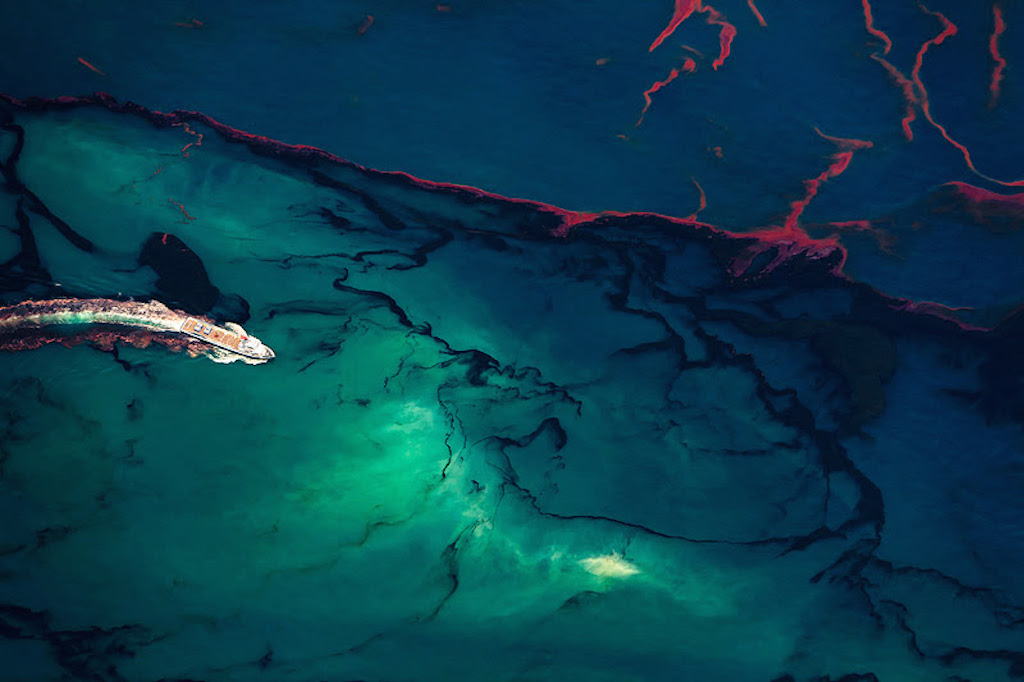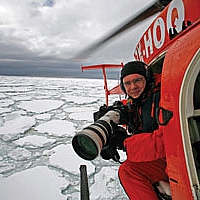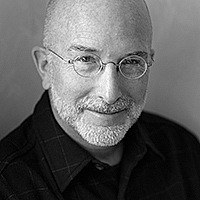
Oil Spill #15 - 2010 BP Deepwater Horizon oil spill, Gulf of Mexico, May (2010) © Daniel Beltrá
Expositions du 17/7/2015 au 5/9/2015 Terminé
VERVE Gallery of Photography 219 East Marcy Street New Mexico 87501 Santa Fe États-Unis
Each of the documentarians in this exhibition--Daniel Beltrá, Jamey Stillings, Wyatt Gallery, Chris Jordan and James Balog as well as our featured emerging artists Alejandro Durán and David Hyams--has mastered fine art photography. Each shares a consuming passion for his work. More importantly, each has a vigorous fervor, a proselytizing drive, to make this world a better place by sharing pictures with us of what we would not otherwise see. Each believes in the true sense of the aphorism "A picture is worth a thousand words." Each says to us, "Come and see what I've seen." Each tells us, "See and you will understand." Each image pleads, "Share with others so they will join us."VERVE Gallery of Photography 219 East Marcy Street New Mexico 87501 Santa Fe États-Unis
On May 5, 2015, the National section of the New York Times carried these four headlines:
• "Drought's Extremes Tallied at Record-Low Lake Mead"
• "Chemicals Used in Fracking Are Detected in Pennsylvania Drinking Water"
• "Strategies Funded to Help Boston Airport Guard Against Effects of Climate Change"
• "E.P.A. Carbon Emissions Proposal Could Save Thousands of Lives, Study Suggests"
.jpg)
#9499 - 21 March 2013
Ivanpah Solar - A hill formation rises above the alluvial slope at the eastern boundaries of Units 2 and 3 with heliostat installation complete.
© Jamey Stillings
Almost 10 years ago, in July of 2005, the British government commissioned Nicholas Stern, a world-renowned economist, to conduct reviews on the economics of climate change. The Stern Review Report on the Economics of Climate Change, published in 2006, can best be summarized with this quote from Stern:
" Climate change is a result of the greatest market failure the world has ever seen. The evidence on the seriousness of the risks of inaction or delayed action is now overwhelming. . . . The problem of climate change involves a fundamental failure of markets: those who damage others by emitting greenhouse gases generally do not pay. . . . We risk damages on a scale larger than the two world wars of the last century. The problem is global and the response must be collaboration on a global scale. "
In 1990, 25 years ago, the United Nation's Intergovernmental Panel of Climate Change (IPCC) issued its "First Assessment Report." The panel concluded: "We are certain of the following: emissions resulting from human activities are substantially increasing the atmospheric concentrations of greenhouse gasses. . . . These increases will enhance the greenhouse effect, resulting on average in an additional warming of the Earth's surface."
.jpg)
Classroom 112, Warren Easton High School, New Orleans, Louisiana - April 2006
© Wyatt Gallery
In 1965, one-half century ago, the Environmental Pollution Board of the President's Science Advisory Committee warned that the "greenhouse effect is a matter of ‘real concern'" because we "will modify the heat balance of the atmosphere to such an extent that marked changes in climate . . . could occur." In February of that year, President Lyndon B. Johnson noted: "This generation has altered the composition of the atmosphere on a global scale through . . . a steady increase in carbon dioxide from the burning of fossil fuels." In 1966, a second warning came from the US National Academy of Sciences Panel on Weather and Climate Modification that increased carbon emissions might also lead to "inadvertent weather modification." By 1978, Robert White, the first administrator of the National Oceanic and Atmospheric Administration, stated: "We now understand that industrial wastes, such as carbon dioxide released during the burning of fossil fuels, can have consequences for climate that pose a considerable threat to future society. "
Today, global warming and climate change are established scientific facts.
The March 12, 2015, issue of Nature magazine (the international weekly journal of science) posits the question of whether the 20th century or its last half, or even dating back to the beginning of the Industrial Revolution (18th to 19th centuries), should be a new geological epoch that recognizes that humans have had a profound impact on the world's environment. It confirms, "Human activity is now global and is the dominant cause of most contemporary environmental change." The journal suggests that the current epoch should be named the "Anthropocene." The proponents argue that humans have "chewed a hole in the ozone layer over Antarctica, doubled the amount of methane in the atmosphere and driven up carbon dioxide concentrations by 30%, to a level not seen in 400,000 years."
.jpg)
Oil Barrels - 2008
Depicts 28,000 42-gallon barrels, the amount of oil consumed in the United States every two minutes (equal to the flow of a medium-sized river).
© Chris Jordan
The Anthropocene Working Group (a 39-member branch of a subcommission of a commission of the International Union of Geological Sciences) has compiled a long list of the changes brought about by humans. They include, to name a few:
Agriculture, construction and the damming of rivers is stripping away sediment at least ten times faster as the natural force of erosion. Along some coastlines, the flood of nutrients from fertilizers has created oxygen-poor "dead zones," and the extra CO2 from fossil-fuel burning has acidified the surface waters of the ocean by 0.1 pH units. The fingerprint of humans is clear in global temperatures, the rate of species extinctions and the loss of Arctic ice.
Many of the changes brought about by humans described above are not visible to the naked or untrained eye. Receding glaciers in remote places go unnoticed. We can see neither carbon dioxide nor methane emissions. Land-use conversion for food and fodder, fuel and fiber, and urban growth result in species extinctions so slowly that they go undetected by the ordinary layperson. Population growth in the modern era has grown from 1 billion at the beginning of the Industrial Revolution to now exceeding 7 billion living human beings. In the 20th century, with better sanitation and medical advances, the population grew from 1.5 billion to 6 billion persons. The human demands on the world's natural resources are staggering, and the waste produced is unmanageable.
.jpg)
Jökulsárlón, Iceland - 2 March 2009
Washed up on the shore of a saltwater lagoon, an "ice diamond" catches the light of the moon.
© James Balog
It isn't clear why climate-change policy is so slow. Is it because the public is so poorly informed? Is the science so hard to understand? Is it because of obfuscation by the carbon industries? Is it because climate deniers have controlled the dialogue? Is it because the solution is so expensive? Is it because the costs will be incurred by this generation but benefit the next? Is it because our policy makers cannot see beyond the next election? Has the deadlock in Congress made it impossible to fashion policies that curb carbon emissions? Has the influence of carbon money in political elections strangled sound public policies?
This exhibition, Cause & Effect, enlists the work of photographers who have set out to make it possible for us to bear witness to these worldwide changes. The work centers on man's impact on our home, this planet. The photographers' challenge is to create photographic images that attract the viewer because of an image's composition, color, patterns and subject matter. Once the observer comes to terms with the essence of the image, he or she becomes a witness to the planet's degradation. The photographers in VERVE's exhibition all make an important contribution in bringing to light significant environmental issues that urgently need to be addressed.




